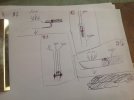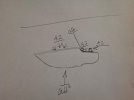It's raining, I'm a bit sick, so I decided to fool around with Photoshop and think of a lock as an alternative to the axis lock.
I love the axis lock and can't wait till the patent expires so other brands can start using it to.
Those familiar with the workings of the axis lock know why it is such a good lock.
Very very sturdy lock, will not fail.
Easy to produce.
Easy to operate.
Keeps the blade closed under spring pressure (unlike frame lock)
Will compensate for wear.
I tried to think of a lock with the same attributes but didn't get much further then a twist on the axis lock. (Like Spyderco's ball bearing lock)
The downsides when compared to the axis lock is you need to keep the lock unlocked manual when opening and closing the blade and it would be less easy to produce.
The upside is it has a half stop lock (although you would have to fiddle with the lock, it's not like a slip joint with a half stop) and it compensates for wear when the blade is closed. (axis does not do this)
I'm not a native English speaker and I'm terrible with technical terms so I will let the pictures do the talking.
Two things to note:
- the locking bar gets thinner towards the blade as you can see on the pictures
- the locking bar locks further then the pivot. (important when blade is closed or half open)
That's a lot of text for something which probably doesn't even work, I'm not an engineer, I would like some feedback
Bullet lock June 28 2014



I love the axis lock and can't wait till the patent expires so other brands can start using it to.
Those familiar with the workings of the axis lock know why it is such a good lock.
Very very sturdy lock, will not fail.
Easy to produce.
Easy to operate.
Keeps the blade closed under spring pressure (unlike frame lock)
Will compensate for wear.
I tried to think of a lock with the same attributes but didn't get much further then a twist on the axis lock. (Like Spyderco's ball bearing lock)
The downsides when compared to the axis lock is you need to keep the lock unlocked manual when opening and closing the blade and it would be less easy to produce.
The upside is it has a half stop lock (although you would have to fiddle with the lock, it's not like a slip joint with a half stop) and it compensates for wear when the blade is closed. (axis does not do this)
I'm not a native English speaker and I'm terrible with technical terms so I will let the pictures do the talking.
Two things to note:
- the locking bar gets thinner towards the blade as you can see on the pictures
- the locking bar locks further then the pivot. (important when blade is closed or half open)
That's a lot of text for something which probably doesn't even work, I'm not an engineer, I would like some feedback
Bullet lock June 28 2014





